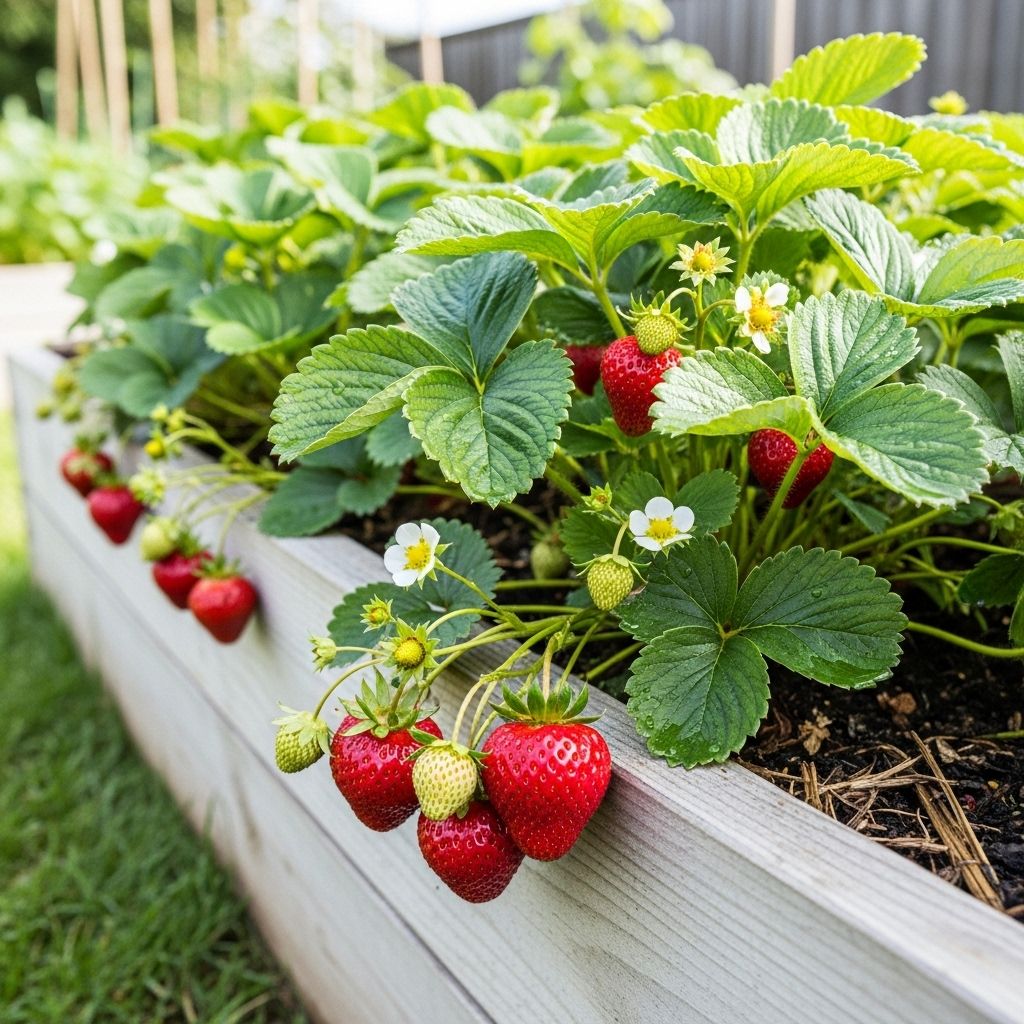How To Grow Strawberries In Raised Beds: A Complete Guide
Elevate your strawberry harvest with practical raised bed strategies for bigger, healthier, and tastier berries all season long.

Image: HearthJunction Design Team
Growing Strawberries in Raised Beds: The Complete Guide
Few fruits signal the start of summer quite as delightfully as fresh strawberries. Whether you’re a novice gardener or a seasoned grower, cultivating strawberries in raised beds offers superior yields, easier maintenance, and tastier berries compared to traditional in-ground planting. This detailed guide covers everything you need to know—from building the perfect bed to harvesting juicy, homegrown berries.
Why Grow Strawberries in Raised Beds?
Raised beds provide an array of advantages for strawberry cultivation:
- Improved Drainage: Prevents root rot and fungal diseases common in waterlogged soils.
- Soil Customization: Fill beds with nutrient-rich, loamy soil tailored to strawberries’ needs.
- Faster Soil Warming: Promotes earlier growth and more productive seasons.
- Better Weed & Pest Control: Raised beds make it easier to spot and manage weeds and pests.
- Accessibility: Gardening at an elevated height reduces back strain and makes berry picking more enjoyable.
Selecting and Building the Ideal Raised Bed
Not all raised beds are created equal when it comes to strawberries. Here’s how to set up an optimal growing space:
Bed Depth and Materials
- Minimum Depth: Ensure beds are at least 10-12 inches deep to accommodate root systems and retain moisture.
- Non-Toxic Materials: Use untreated wood, food-grade metal, or recycled plastic to avoid leaching chemicals into your fruit.
Bed Placement
- Sun Exposure: Position your bed in full sunlight—6-8 hours of direct sun daily is ideal. In hot climates, offer some afternoon shade or use shade cloth to protect plants from excessive heat.
Bed Size and Layout
- Dimensions: Standard beds are 4 feet wide by any desired length, facilitating easy access from all sides without stepping on the soil.
- Pathways: Leave at least 2 feet of walk space between rows or beds for comfortable maintenance and harvesting.
Choosing the Best Strawberry Varieties for Raised Beds
Not all strawberry types perform equally in raised beds. Consider these top performers:
- Everbearing Varieties: Produce multiple harvests throughout the season, making them ideal for consistent picking. These thrive in beds and are often recommended for home gardeners.
- Day-Neutral Varieties: Continue to set fruit regardless of daylength, providing steady production—perfect for extended harvests.
- June-Bearing Varieties: Offer a single but large flush of fruit, excellent for making jam or processing bulk berries. However, they may require more space.
- Alpine Strawberries: Compact and shade-tolerant, great for small beds or containers, though they have smaller fruit.
Recommended Spacing
- Provide each strawberry plant with roughly 1 square foot (about 12-15 inches apart) to avoid overcrowding and promote healthy fruiting.
Preparing the Perfect Soil Mix
Strawberries love fertile, well-draining, slightly acidic soil. Here’s how to create the ideal bed mix:
- Soil Type: Combine high-quality topsoil, compost, and a small amount of sand for aeration.
- Soil pH: Aim for a slightly acidic pH between 6.0 and 6.5 for best fruit quality and nutrient uptake.
- Drainage: Ensure the mix is loose and friable—dense, heavy clay won’t do.
Soil Amendment Tips
- Add organic matter such as composted manure or leaf mold each season to boost nutrients.
- Incorporate a slow-release, balanced fertilizer at planting time to support vigorous early growth.
Planting Strawberries in Raised Beds
Follow these steps for a thriving berry patch:
Step-by-Step Planting Guide
- Transplant at the Right Time: Plant bare-root or potted strawberries in early spring as soon as soil can be worked, or in fall in mild climates.
- Prepare the Bed: Remove any weeds and rake the soil surface smooth.
- Dig Holes: Make holes deep enough for roots to spread comfortably without curling. The crown (where leaves meet roots) should sit at soil level.
- Spacing: Place each strawberry plant 12-15 inches apart in all directions; rows should be 3-4 feet apart if you have multiple beds.
- Water In: After planting, water thoroughly to help roots establish.
Essential Care for Raised Bed Strawberries
Watering
- Strawberries prefer consistently moist but not soggy soil. Water 2-3 times per week, more during hot spells.
- Avoid overhead irrigation—use drip lines or soaker hoses to reduce leaf diseases.
Mulching
- Mulch beds with clean straw, pine needles, or wood chips to suppress weeds, conserve moisture, and keep berries clean.
- Renew mulch annually before fruit sets for best results.
Fertilizing
- Feed with a balanced liquid fertilizer midseason, or use slow-release fertilizer at planting time—avoid overfertilizing or you’ll grow leaves instead of fruit.
Weed and Pest Control
- Keep beds well-weeded; weeds compete with strawberries for nutrients and water.
- Protect berries from birds or rodents with netting or row covers as fruit begins to ripen.
- Check regularly for slugs and snails, especially in damp mulch.
Pruning and Renovation Techniques
Pruning and renovating your strawberry patch keeps plants healthy and productive year after year.
Pruning During the Season
- Trim off yellowing or diseased leaves as they appear to avoid spread of problems.
- Pinch off the first flush of flowers in spring for newly planted beds; this encourages stronger root development and healthier plants.
- Regularly remove runners (long stolons sent out by mother plants) unless you want to propagate new plants; runners divert energy from fruit production.
Thinning and Bed Renovation
- After peak harvest, thin overcrowded sections by removing older, less productive crowns to allow younger plants room to grow.
- Renovate the bed annually by mowing foliage, removing weeds, fertilizing lightly, and adding fresh mulch to rejuvenate the patch.
Smart Companion Planting for Strawberries
Certain plants can benefit strawberries by boosting pollinator activity, repelling pests, and enhancing soil health. Consider these companions:
- Borage: Attracts bees and improves berry flavor.
- Lettuce and Spinach: Grow well in the cool, shady spaces between strawberry plants.
- Onions and Garlic: Help deter aphids and other pests.
- Herbs (e.g., Thyme or Chives): Low-growing herbs can suppress weeds and contribute to biodiversity.
Avoid planting strawberries near cabbage family crops, which may compete for nutrients and attract similar pests.
Harvesting and Storing Your Strawberries
Harvest berries when fully red and fragrant. Gently twist the fruit from the stem, taking care not to damage the plant. Eat immediately for best flavor or refrigerate briefly. For longer storage, freeze berries in a single layer or preserve them as jam.
Troubleshooting Common Raised Bed Strawberry Problems
- Small, Sour, or Misshapen Fruit: Usually due to poor pollination, crowded beds, or nutrient imbalances. Ensure adequate spacing and attract pollinators with companion flowers.
- Leaf Spot or Mildew: Improve air circulation by not crowding plants, watering at the base, and promptly removing affected foliage.
- Pest Damage: Use row cover, slug traps, or organic sprays as needed, and harvest berries regularly to discourage critters.
Tips for Maximizing Raised Bed Strawberry Success
- Rotate berry beds every 3-4 years to reduce disease build-up.
- Start with disease-free, high-quality crowns or plugs.
- Renew mulch each year, especially after winter.
- Consider growing a few plants in containers or hanging baskets if space runs short or for extra protection from pests.
Final Thoughts
Growing strawberries in raised beds transforms an ordinary patch of garden into a prolific, vibrant berry oasis. With the right preparation, care, and a handful of expert-approved strategies, you’ll enjoy bountiful harvests—and probably never return to in-ground strawberry growing. Remember:
- Use deep, non-toxic beds with full sun and rich soil
- Choose suitable varieties like everbearing or day-neutral strawberries
- Practice regular pruning and thinning
- Keep weeds at bay and mulch thoughtfully
- Water wisely—avoid soaking the leaves
- Leverage companion planting and renew the patch annually
Frequently Asked Questions (FAQs)
Q: How deep should my raised bed be for strawberries?
A minimum of 10-12 inches is recommended for healthy root systems and sufficient moisture retention.
Q: How much sunlight do strawberries need in a raised bed?
Strawberries thrive in full sunlight—aim for at least 6-8 hours daily. Provide light afternoon shade in hot climates to prevent stress.
Q: What’s the best soil mix for strawberries?
Use a mix of loamy soil, compost, and a bit of sand with a pH of 6.0–6.5 for optimal drainage and nutrition.
Q: Should I pinch off flowers the first year?
Yes, removing early flowers in spring helps new plants develop robust roots, leading to larger harvests in subsequent seasons.
Q: Can strawberries be grown in containers if I run out of bed space?
Absolutely! Strawberries grow well in pots or hanging baskets as long as they receive enough sunlight, have good drainage, and are spaced properly.
Q: How do I prevent slugs and birds from eating my berries?
Use bird netting, floating row covers, and straw mulch to deter critters. Remove hiding places for slugs and set up traps if needed.
Q: What is the best way to fertilize strawberries in raised beds?
Apply a balanced, slow-release fertilizer at planting, then supplement with midseason liquid feed if necessary. Avoid excessive nitrogen, which favors leaves over fruit.
Q: How often should I replace my strawberry plants?
Replace older plants every 3-4 years to maintain productivity and minimize disease risk. Use vigorous runners or fresh nursery plants to renew beds.
References
Read full bio of Srija Burman












